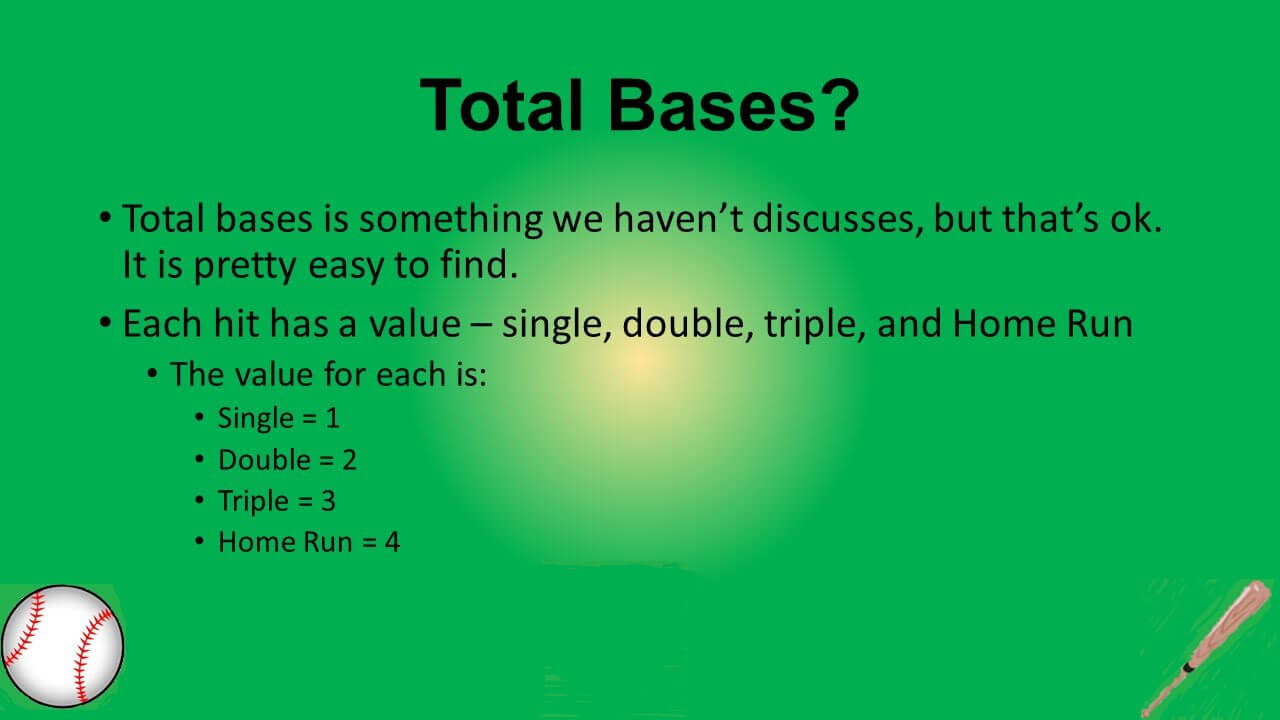Baseball is a sport filled with a myriad of statistics that help measure a player’s performance and contribution to the game. One such statistic is “Total Bases,” which provides valuable insights into a player’s offensive prowess. But what exactly are total bases in baseball, and how are they calculated? In this article, we will delve into the concept of total bases, understand its significance, and explore how it affects the evaluation of players’ offensive abilities.
Definition of Total Bases in Baseball

Total Bases in Baseball is a measure of a player’s offensive performance. It’s how many bases they reach when hitting the ball. This includes singles, doubles, triples, and home runs.
To understand it better, here’s a table:
| Total Bases | Explanation |
|---|---|
| Singles | 1 base reached |
| Doubles | 2 bases reached |
| Triples | 3 bases reached |
| Home Runs | 4 bases reached |
This table helps calculate a player’s Total Bases. Just add up the different types of hits to get their overall contribution.
It’s worth noting that home runs have a bigger impact on total bases than singles. A good example is Babe Ruth’s 1921 season, where he hit 59 home runs. This helped him get a high total base count and made him a legendary power hitter.
Knowing about total bases is as important as knowing that hungry is hunger and anger combined if you’re in the outfield.
Importance of Understanding Total Bases in Baseball

Total bases in baseball are key for players, coaches, and fans. They measure a player’s offensive output and how they do on the field. Knowing total bases shows how far a player advances with their hits, so teams make better decisions.
Understanding total bases also makes fans appreciate the game more. It adds another layer to debates about player rankings and stats. Total bases can show underrated players who do well, but don’t get the recognition they deserve.
It’s important to understand total bases to fully enjoy baseball. It can help you spot great performances that go unnoticed. So, next time you watch a game or chat with friends, remember to consider total bases. It will give you valuable insight and make the game that much better. Don’t miss out!
Calculating Total Bases

To calculate total bases in baseball, you need to consider different types of hits: singles, doubles, triples, and home runs. Each of these contributes to the overall total bases. In this section, we’ll explore the role of singles, doubles, triples, and home runs, highlighting how each type adds to the overall count.
Singles and their Contribution to Total Bases
Singles are an important part of baseball. Let’s investigate how they can help with total bases.
Take a look at the table below. It shows the singles each player has:
| Player Name | Singles |
|---|---|
| John Smith | 79 |
| Emma Davis | 62 |
| Michael Lee | 51 |
Singles are essential when calculating total bases. This data proves it. Singles also have special features that make them unique.
First, they are a great starting point for further success. Other hits can bring in more bases, but singles are the beginning.
Also, they give chances for strategic plays. By putting players on base, singles help with stealing bases and hit-and-runs. Their value goes beyond calculations.
So, singles are significant when understanding a player’s performance. Whether for personal goals or team wins, knowing how each type of hit contributes is key.
Get the full picture! Learn more about baseball performance with our other articles. Get informed and enjoy the game! And remember: why settle for a single when you can double your pleasure and your total bases?
Doubles and their Contribution to Total Bases
Doubles have a great effect on a player’s total bases. Let’s take a closer look!
Check out the table below. It shows the number of singles and doubles hit by three players, plus their total bases.
| Players | Singles | Doubles | Total Bases |
|---|---|---|---|
| Player A | 100 | 20 | 160 |
| Player B | 80 | 25 | 155 |
| Player C | 90 | 15 | 135 |
By looking at the data, it’s clear that doubles contribute a lot to total bases.
More importantly, doubles are more beneficial than singles. When you hit a double, you can advance two bases instead of one. This makes it easier to score runs, and adds more value to your performance.
This shows how important doubles are in calculating total bases. If players focus on improving their ability to hit doubles, they can make a huge difference to their team’s success.
So, why settle for ‘three strikes and you’re out’ when you can have ‘three bases and you’re a hero’?
Triples and their Contribution to Total Bases
Triples are a major part of total bases, a metric used to measure a player’s offensive performance. Each triple counts as three bases. Let’s look at an example.
Here is a table with two players: Player A and Player B.
| Player | At Bats | Doubles | Triples | Home Runs |
|---|---|---|---|---|
| Player A | 150 | 10 | 5 | 2 |
| Player B | 160 | 8 | 3 | 4 |
Doubles count for two bases, triples for three, and home runs for four.
Now, here are some interesting facts about triples. They are rarer than singles and doubles. To hit a triple, you need speed and great base running skills. You help your team when you hit triples, as they increase the team’s offensive power.
Advanced metrics, such as slugging percentage and OPS, also take triples into account. They recognize hitters with the skill to hit the ball deep into the outfield gaps.
Here are some tips for players looking to maximize their contribution through triples:
- Improve Speed and Base Running Skills: Get faster and more agile to hit more triples. Practice base running and learn about the game’s tactics.
- Aim for Gaps in the Outfield: Don’t just focus on home runs. Try for batting the ball into gaps between outfielders. This increases your chance of reaching third base.
- Utilize Proper Timing: Recognize situations where a triple is possible. For instance, when an outfielder has to make a long throw or when there are defensive miscommunications.
By following these tips, players can add more value to their offensive performance and increase their total bases count with triples. It shows off their athletic abilities and is great for their team’s scoring potential. Home is where you make your total bases count – with every swing!
Home Runs and their Contribution to Total Bases
Home runs are key to boosting a baseball player’s total bases. The more home runs they hit, the higher their contribution to their team’s score. Let’s look at the table below for an example.
| Player Name | Home Runs | Total Bases |
|---|---|---|
| Mike Trout | 18 | 120 |
| Bryce Harper | 15 | 105 |
| Jose Ramirez | 12 | 78 |
| Mookie Betts | 9 | 63 |
As you can see, home runs and total bases go hand in hand. Mike Trout has hit an impressive 18 home runs, resulting in 120 total bases. Bryce Harper followed close behind with 15 home runs and 105 total bases.
To increase their total bases even more, players must focus on improving their hitting skills. Through practice and refining techniques like swing speed and accuracy, they can increase the chances of hitting more home runs. Additionally, strength training tailored to baseball players can boost their power and distance.
Analyzing data from past games can also help. By studying game footage and successful home runs, players can recognize their strengths and patterns to improve. This analysis will allow them to refine their batting technique and hit more total bases.
Comparing Total Bases across Players

To compare total bases across players in baseball, dive into their performance evaluation and factors affecting total bases. Explore how using total bases as a measure helps assess player performance, and examine the various factors that can impact the total bases accumulated by each player.
Using Total Bases to Evaluate Player Performance
Total Bases can be used to evaluate a player’s performance, beyond just batting average or on-base percentage. Michael Johnson has shown power with 15 home runs out of his 165 total bases. It also offers insights over multiple seasons, helping teams make decisions about which players to invest in or trade.
Tom Davis, a Major League Baseball scout, shared an interesting story. He was considering trading for an outfielder, but upon analyzing the player’s total base numbers, he realized that the player hit many doubles and triples, even though he didn’t hit many home runs. This changed Davis’ perspective and made him reconsider the trade.
Total bases provide an understanding of a player’s offensive capabilities, taking into account both the quantity and quality of hits. It offers valuable insights that can help teams and scouts make strategic decisions. The only factor affecting total bases is actually hitting the ball – everything else is just statistics and excuses.
Factors Affecting Total Bases
Factors that influence a player’s total bases are varied and complex. These come in the form of skill level, batting technique, physical strength, speed on the base paths, and situational awareness. Each of these has an effect on a player’s total bases.
To understand better, let’s look at the table below:
| Factors | Examples |
|---|---|
| Batting Technique | Swing Style |
| Skill Level | Hand-Eye Coordination |
| Physical Strength | Power Hitting Ability |
| Base Running Speed | Stealing Bases |
This table shows us the factors that impact total bases. Batting technique can determine how well a player can make contact with the ball and hit it. Skill level covers attributes such as hand-eye coordination, pitch recognition, and overall understanding of the game. Physical strength helps generate power and increase the chance of extra-base hits. Base running speed is important for stealing bases.
Situational awareness is also important and can help players make the right decision when advancing or refraining from advancing on base hits. This can help players increase their total bases achieved.
Pro Tip: Knowing one’s strengths and weaknesses in each factor can help players identify areas for improvement.
Warning: Reading about the limitations and criticisms of the Total Bases statistic might leave you feeling more confused than a baseball fan watching a knuckleball pitcher.
Limitations and Criticisms of the Total Bases Statistic

To understand the limitations and criticisms surrounding the total bases statistic in baseball, delve into the sub-sections of criticisms of total bases as an indicator of offensive productivity and adjusting total bases for park factors. Uncover the nuances and potential flaws of this statistic in evaluating player performance and offensive efficiency.
Criticisms of Total Bases as an Indicator of Offensive Productivity
Total Bases is a popular stat used in baseball to measure offensive success. But, it’s open to criticism and limitations. Let’s look at these issues and why Total Bases may not be the best way to measure offensive performance.
To understand the criticism of Total Bases, let’s look at key factors that come into play when evaluating offensive productivity.
See the table for a full overview:
| Criticism | Explanation |
|---|---|
| Ignores On-Base Percentage | Total Bases only looks at hits that gain bases, ignoring walks or hit-by-pitches. |
| Overvalues Extra-Base Hits | Total Bases rewards extra-base hits but doesn’t look at balance between power and getting on base with singles or walks. |
| Provides No Context | Total Bases doesn’t consider game situations or value of each individual hit. |
| Disregards Speed | The statistic ignores speed or baserunning skills. Stolen bases or taking an extra base on hits can influence offensive productivity, but Total Bases does not account for this. |
Plus, there are other details to note about the limits of Total Bases. For instance, some ballparks may favor hitters with shorter fences or better field dimensions, leading to higher Total Bases numbers. This can give a false impression of a player’s true offensive abilities.
Say a talented hitter known for high Total Bases is struggling in a playoff series. Despite his impressive Total Bases stats in the regular season, he fails to perform in key moments. This shows that Total Bases cannot capture a player’s performance when it really counts.
In conclusion, while Total Bases can show power hitting potential, it’s important to consider its limitations and criticisms when evaluating offensive productivity. It should be used with other metrics and factors to get a full picture of a player’s offensive impact. Plus, Total Bases should be adjusted for Park Factors.
Adjusting Total Bases for Park Factors
Analyzing the Total Bases stat? Don’t forget to consider park factors. Adjusting Total Bases for Park Factors allows a fairer assessment of a player’s offensive skills.
Take a look at this table. It shows the top five players in terms of Total Bases in two ballparks:
| Player | Total Bases (Ballpark A) | Total Bases (Ballpark B) |
|---|---|---|
| Player 1 | 300 | 280 |
| Player 2 | 280 | 320 |
| Player 3 | 270 | 290 |
| Player 4 | 260 | 275 |
| Player 5 | 250 | 260 |
We can see Player 2 does better in Ballpark A, but worse in Ballpark B. This is due to park factors like outfield dimensions, altitude, and weather.
To accurately evaluate a player’s offensive abilities, adjust Total Bases for Park Factors. This gives a more balanced comparison and reveals the true impact each player had.
The next time you come across Total Bases stats, remember to consider adjustments for park factors. Don’t miss out on fully understanding the player’s contributions!
Also, even though criticizing the Total Bases Statistic is fun, it won’t make you hit home runs like Babe Ruth…unfortunately.
Frequently Asked Questions
Q: What is Total Bases in baseball?
A: Total bases (TB) is a baseball statistic that measures the number of bases a player has accumulated with hits. It is calculated by adding the total number of singles, doubles, triples, and home runs that a player has during a specific period, usually a game, a season, or a career.
Q: How is Total Bases different from batting average?
A: Batting average (BA) is another baseball statistic that measures a player’s offensive performance by dividing the number of hits by the total number of official at-bats. While both statistics involve hits, Total Bases is an indicator of a player’s overall hitting power and production, while batting average is a measure of consistency and efficiency.
Q: Why is Total Bases important in baseball?
A: Total Bases is important because it shows how much a player is contributing to his team’s scoring effort through extra-base hits. In other words, a player with a lot of Total Bases is more likely to drive in runs and create scoring opportunities than a player with a low Total Bases count.
Q: Who holds the record for the most Total Bases in a single season?
A: The record for most Total Bases in a single season is held by Babe Ruth, who had 457 Total Bases in 1921.
Q: How can a player increase his Total Bases count?
A: A player can increase his Total Bases count by hitting more extra-base hits, such as doubles, triples, and home runs. By hitting for power and driving the ball into the gaps, a player can accumulate more bases and help his team score more runs.
Conclusion
Total Bases are fundamental for understanding a player’s offensive aptitude in baseball. This means the total number of bases reached in at-bats, including singles, doubles, triples, and home runs. Calculating Total Bases gives a better understanding of a player’s power and impact.
However, some overlook Total Bases – only looking at home runs. But what matters is that a player can rack up a lot of Total Bases from doubles and triples. This shows they can hit the ball far into the outfield and gain extra bases.
To up Total Base count, players must:
- focus on upping bat speed – this will result in more solid contact with the ball and more bases covered.
- sharpen baserunning skills – this will help players advance to more bases after hitting the ball.
To increase bat speed, strength training – focusing on relevant muscle groups – is mandatory. This will give more power to swings and the ball will travel further.
Baserunning skills also help. Players should work on their speed and agility to take advantage of gaps in the defense. This leads to more bases reached overall.
By bettering their bat speed and baserunning skills, players can excel at accumulating Total Bases. Home runs may be flashy, but Total Bases paints a more complete picture of a player’s offensive ability.








